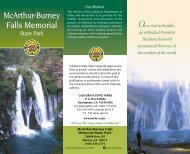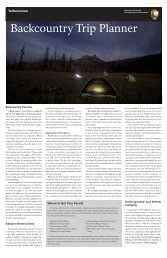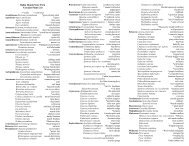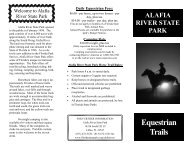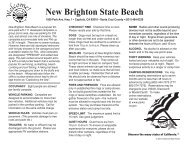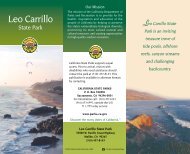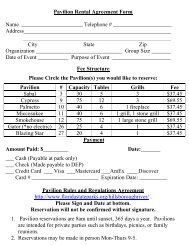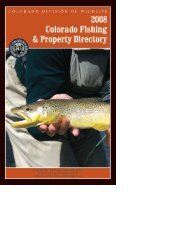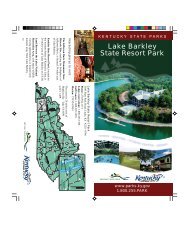Create successful ePaper yourself
Turn your PDF publications into a flip-book with our unique Google optimized e-Paper software.
ill, c.<br />
1849<br />
“Boys, by God, I believe<br />
I’ve found a gold mine.”<br />
When Mr. Scott—a<br />
carpenter working on the<br />
mill wheel—disputed his<br />
claim, Marshall replied<br />
positively, “I know it to be<br />
nothing else.” Marshall<br />
pounded it on a rock, and<br />
the cook, Jenny Wimmer,<br />
boiled it in lye soap. It<br />
passed all their tests—it<br />
was pure gold.<br />
Four days later Marshall<br />
rode to the fort with<br />
samples of the gold.<br />
Sutter consulted his<br />
encyclopedia, tried various tests, and<br />
confirmed Marshall’s conclusion. Mindful<br />
of their investment in the mill, they agreed<br />
to keep the news secret until the mill<br />
was in operation. After all, this was not<br />
the first time gold had been discovered<br />
in California, and there was no reason<br />
to assume that this find was particularly<br />
important.<br />
But it was a secret that could not be<br />
kept. In a letter to General Mariano<br />
Vallejo, Sutter bragged about the<br />
discovery. Mormon elder Sam Brannan,<br />
who operated a general store at the fort,<br />
went to the mill to see for himself. Several<br />
Mormon mill workers readily gave him a<br />
tithe of the gold they had found. When<br />
Brannan visited San Francisco in May,<br />
he paraded the streets waving a quinine<br />
bottle full of gold, shouting, “Gold! Gold!<br />
Early drawing of Sutter’s Mill, c. 1849<br />
Photo by Betty Sederquist<br />
Gold from the American<br />
River!” By the end of May,<br />
San Francisco was reported<br />
to be “half empty” as the<br />
able-bodied men departed<br />
for the mines. The excitement<br />
grew when an army officer<br />
carried a tea caddy full of gold<br />
to Washington, D.C. Shortly<br />
after President James K.<br />
Polk confirmed the rumors,<br />
thousands came to join the<br />
trek to the Gold Country.<br />
Chinese Immigrants<br />
News of the gold discovery<br />
spread throughout the world.<br />
In China, California was called<br />
Gum San—“Gold Mountain.” Chinese workers,<br />
lured to California by a promised golden<br />
mountain from which they could literally carve<br />
out their fortune, were fleeing years of war and<br />
poverty. Chinese miners at Coloma—thought<br />
to have numbered about 50—were so efficient<br />
at finding gold that other miners complained<br />
of a “Chinese invasion.” Hostilities among<br />
the miners helped spark discriminatory<br />
taxes and laws enforced only against<br />
“foreign” miners.<br />
The easy-to-find placer gold at Coloma<br />
played out early. By 1857 many miners had<br />
left, but a few Chinese miners remained<br />
to work the played-out placer sites. Two<br />
structures used by the Chinese remain in<br />
the park today—the Man Lee building,<br />
which housed a Chinese trading and<br />
banking company as well as a hardware<br />
store, and the Wa Hop Store, once leased<br />
to a Chinese merchant of that name.<br />
They currently house exhibits of gold<br />
mining techniques and the mercantile<br />
goods needed by the Chinese miners.<br />
The Wah Hop building—<br />
a Gold Rush-era Chinese store<br />
Living history program at the park’s 49er Family Festival




